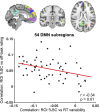Spontaneous default network activity reflects behavioral variability independent of mind-wandering
- PMID: 27856733
- PMCID: PMC5137714
- DOI: 10.1073/pnas.1611743113
Spontaneous default network activity reflects behavioral variability independent of mind-wandering
Abstract
The brain's default mode network (DMN) is highly active during wakeful rest when people are not overtly engaged with a sensory stimulus or externally oriented task. In multiple contexts, increased spontaneous DMN activity has been associated with self-reported episodes of mind-wandering, or thoughts that are unrelated to the present sensory environment. Mind-wandering characterizes much of waking life and is often associated with error-prone, variable behavior. However, increased spontaneous DMN activity has also been reliably associated with stable, rather than variable, behavior. We aimed to address this seeming contradiction and to test the hypothesis that single measures of attentional states, either based on self-report or on behavior, are alone insufficient to account for DMN activity fluctuations. Thus, we simultaneously measured varying levels of self-reported mind-wandering, behavioral variability, and brain activity with fMRI during a unique continuous performance task optimized for detecting attentional fluctuations. We found that even though mind-wandering co-occurred with increased behavioral variability, highest DMN signal levels were best explained by intense mind-wandering combined with stable behavior simultaneously, compared with considering either single factor alone. These brain-behavior-experience relationships were highly consistent within known DMN subsystems and across DMN subregions. In contrast, such relationships were absent or in the opposite direction for other attention-relevant networks (salience, dorsal attention, and frontoparietal control networks). Our results suggest that the cognitive processes that spontaneous DMN activity specifically reflects are only partially related to mind-wandering and include also attentional state fluctuations that are not captured by self-report.
Keywords: daydreaming; default mode network; resting state; spontaneous thought; sustained attention.
Conflict of interest statement
The authors declare no conflict of interest.
Figures









Comment in
-
Reply to Csifcsák and Mittner: Fitting data to neural models of mind-wandering.Proc Natl Acad Sci U S A. 2017 Jul 25;114(30):E6033. doi: 10.1073/pnas.1707780114. Epub 2017 Jul 13. Proc Natl Acad Sci U S A. 2017. PMID: 28705871 Free PMC article. No abstract available.
-
Linking brain networks and behavioral variability to different types of mind-wandering.Proc Natl Acad Sci U S A. 2017 Jul 25;114(30):E6031-E6032. doi: 10.1073/pnas.1705108114. Epub 2017 Jul 13. Proc Natl Acad Sci U S A. 2017. PMID: 28705872 Free PMC article. No abstract available.
Similar articles
-
The role of the default mode network in component processes underlying the wandering mind.Soc Cogn Affect Neurosci. 2017 Jul 1;12(7):1047-1062. doi: 10.1093/scan/nsx041. Soc Cogn Affect Neurosci. 2017. PMID: 28402561 Free PMC article.
-
Functional connectivity within and between intrinsic brain networks correlates with trait mind wandering.Neuropsychologia. 2017 Aug;103:140-153. doi: 10.1016/j.neuropsychologia.2017.07.006. Epub 2017 Jul 10. Neuropsychologia. 2017. PMID: 28705691
-
Dynamic functional connectivity of the default mode network tracks daydreaming.Neuroimage. 2014 Oct 15;100:471-80. doi: 10.1016/j.neuroimage.2014.06.044. Epub 2014 Jun 25. Neuroimage. 2014. PMID: 24973603
-
A Neural Model of Mind Wandering.Trends Cogn Sci. 2016 Aug;20(8):570-578. doi: 10.1016/j.tics.2016.06.004. Epub 2016 Jun 25. Trends Cogn Sci. 2016. PMID: 27353574 Review.
-
Just a thought: How mind-wandering is represented in dynamic brain connectivity.Neuroimage. 2018 Oct 15;180(Pt B):505-514. doi: 10.1016/j.neuroimage.2017.07.001. Epub 2017 Jul 3. Neuroimage. 2018. PMID: 28684334 Review.
Cited by
-
Coexistence of thought types as an attentional state during a sustained attention task.Sci Rep. 2023 Jan 28;13(1):1581. doi: 10.1038/s41598-023-28690-1. Sci Rep. 2023. PMID: 36709372 Free PMC article.
-
Reply to Csifcsák and Mittner: Fitting data to neural models of mind-wandering.Proc Natl Acad Sci U S A. 2017 Jul 25;114(30):E6033. doi: 10.1073/pnas.1707780114. Epub 2017 Jul 13. Proc Natl Acad Sci U S A. 2017. PMID: 28705871 Free PMC article. No abstract available.
-
Resting Brain Fluctuations Are Intrinsically Coupled to Visual Response Dynamics.Cereb Cortex. 2021 Feb 5;31(3):1511-1522. doi: 10.1093/cercor/bhaa305. Cereb Cortex. 2021. PMID: 33108464 Free PMC article.
-
Neural mechanisms of brand love relationship dynamics: Is the development of brand love relationships the same as that of interpersonal romantic love relationships?Front Neurosci. 2022 Nov 10;16:984647. doi: 10.3389/fnins.2022.984647. eCollection 2022. Front Neurosci. 2022. PMID: 36440289 Free PMC article.
-
Pupillary Dynamics Link Spontaneous and Task-Evoked Activations Recorded Directly from Human Insula.J Neurosci. 2020 Aug 5;40(32):6207-6218. doi: 10.1523/JNEUROSCI.0435-20.2020. Epub 2020 Jul 6. J Neurosci. 2020. PMID: 32631937 Free PMC article.
References
-
- Shulman GL, et al. Common blood flow changes across visual tasks: II. Decreases in cerebral cortex. J Cogn Neurosci. 1997;9(5):648–663. - PubMed
-
- Smallwood J, Schooler JW. The restless mind. Psychol Bull. 2006;132(6):946–958. - PubMed
-
- Buckner RL, Andrews-Hanna JR, Schacter DL. The brain’s default network: Anatomy, function, and relevance to disease. Ann N Y Acad Sci. 2008;1124:1–38. - PubMed
-
- Christoff K, Irving ZC, Fox KC, Spreng RN, Andrews-Hanna JR. Mind-wandering as spontaneous thought: A dynamic framework. Nat Rev Neurosci. 2016;17(11):718–731. - PubMed
Publication types
MeSH terms
Grants and funding
LinkOut - more resources
Full Text Sources
Other Literature Sources

